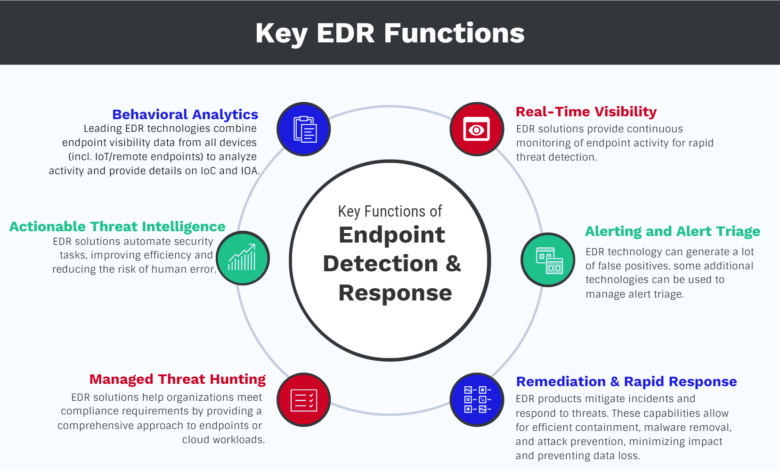How EDR Software Enhances Incident Response and Threat Hunting

EDR software collects telemetry data from endpoints to quickly identify and respond to threats. It often incorporates automation capabilities that can isolate compromised endpoints, update security policies, and other tasks to cut response coordination time and improve security.
EDR also includes forensic capabilities that help investigate attacks. This allows analysts to determine how an attacker penetrated the network, gained access to authentication credentials, and accessed sensitive information.
Table of Contents
Integration
A cyberattack can infiltrate endpoints quickly, leaving little time to respond. EDR tools that are well-integrated with other security software systems, such as SIEM (security information and event management), threat intelligence platforms, and firewalls, help to eliminate blind spots. These solutions provide threat intelligence feeds, third-party integration capabilities, and custom rule creation. These capabilities help reduce the number of alerts received and prioritized by human operators, minimizing the chance of attack evasion and cutting response coordination time.
EDR tools can detect and stop advanced threats, such as file-less malware, zero-day exploits, and ransomware, in their tracks by using behavioral approaches that look for indicators of an attack. When a potential threat is detected, the EDR tool can take immediate action, such as locating and halting suspicious activity or executing an automated response without interrupting business operations. When an attack is discovered, EDR software can perform forensic investigations on the file to identify vulnerabilities and prevent future hazards. Just as a plane’s black box captures data during a flight, an EDR solution can collect device telemetry such as processes running, programs installed, and network connections to help understand what led to the attack. This information can then be used to develop cyber threat coping strategies for future prevention. This forensic investigation process is often accomplished via sandboxing, which enables an EDR solution to observe a malicious file without risking the network or endpoints.
Real-time Alerts
Security teams must be notified in real-time of anomalous activity that may indicate a threat. This is critical to reducing mean-time-to-resolution (MTTR) for responding to and mitigating threats. This can be achieved through real-time alerts configured using workspace templates and ingesting data from various sources, including SIEM, endpoint detection and response solutions, threat intelligence, and more.
Incorporating attack intelligence into alerting allows security operations centers to understand the tactics, techniques, and procedures (TTPs) used by threat actors in the context of your environment. This can help prioritize and analyze threats to ensure they are responded to effectively, minimizing the impact on your organization. This intelligence can be derived from internal incident response repositories, third-party vendors, or by participating in security information-sharing communities.
XDR enables security leaders to deploy and execute automation with a button. This can enable SOC teams to respond to alerts, improve mean-time-to-resolution, and make their job more manageable by removing manual steps. When selecting a solution, look for one that offers approachable automation that is easy to build and customizable. It is also important to consider integration capabilities and a flexible library of out-of-the-box and custom integrations.
Isolation
The EDR solution collects data from endpoints and networks, including system logs, file changes, network traffic, and user behavior, and identifies suspicious or anomalous activities. These detection methods can include signature-based detection, behavioral analysis, and machine learning. In addition, many solutions can use threat intelligence to provide context by using real-world examples of cyberattacks and comparing them against network and endpoint activity.
When a potential threat is detected, the EDR tool can respond immediately. This can include re-imaging the affected endpoint or quarantining malicious files to limit an attack’s spread and impact. Additionally, some solutions can automatically isolate the endpoint, minimizing business impact by eliminating an attacker’s ability to move laterally within the organization’s network. The forensic capabilities that EDR tools offer can help security teams quickly identify how an incident occurred and what information may have been compromised. This data can then be used to improve the organization’s security posture.
Forensics
Unlike legacy antivirus and firewalls, limited to signature-based detection, EDR provides visibility into unknown threats. Behavior analysis identifies malware and advanced attacks at the earliest stages before they reach your networks or cause significant damage. This is achieved by detecting abnormal activity and providing alerts on suspicious behavior, such as running processes, programs installed, or network connections.
Once a threat is detected, the EDR solution takes fast action. It isolates the affected endpoint, preventing it from spreading and blocking access to critical systems. It also notifies the security team to take further action. This minimizes the time attackers can remain undetected in your network (known as dwell time) and reduces the risk of data loss or business disruption.
Forensic capabilities help investigators understand the attack, determine its root cause, and prevent similar incidents in the future. For example, some solutions can record the system memory of suspect endpoints to find artifacts and gather evidence that attackers have been on the system and what they have been doing.
By integrating with network defense tools, such as NDR and SIEMs, EDR can unite device-level data with network-level telemetry to improve detection capabilities across the attack lifecycle. The unified view of endpoint and network information makes it easier to identify blindspots and vulnerabilities, often overlooked by traditional tools.



